One of the most important things to us here at CCF is the people who make up our community. Every month we will be putting the spotlight on one of our members.
Team Spotlight — Propagation Team – October 2023 Newsletter
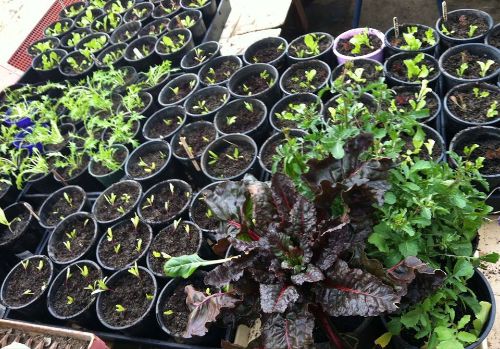
The basic role of the Propagation Team is to grow vegetables, herbs, and flowers from seed or cuttings for use at the Canberra City Farm. Simple, right? When we — Deb Denehy and Beth Johnston — started at the Farm about five years ago, that’s what we did at the Monday morning working bee. Carol Ayliffe and Christine Vincent looked after everything else and told us what needed to be started and what needed to be pricked out. But then in 2021, Carol moved on and Christine moved to Braidwood — so we had to figure out what else was involved.
We learned that there were a lot of other tasks to be managed:
- deciding what needed to be planted and when, which required liaison with the teams managing the four crop-rotation beds and the wicking beds;
- sourcing seeds, cuttings, pots, seed-raising mix, and potting soil;
- maintaining the heated propagation bench and managing the temperature;
- maintaining the watering system and the schedule for watering — including changing the battery for the timer regularly (we learned this from experience: watering failed, seedlings died!);
- timing of pricking out of seedlings and when they are ready for “hardening off” and for sale; and
- dealing with pests, including rats (another traumatic experience solved by John’s rat cages — keeping them out rather than in).
And that was just in the first couple of months! Christine provided heaps of information and moral support from afar throughout that time, and continues to do that and to be the Propagation Team’s liaison with the CCF committee.
Uta Lovering has joined the team recently. She has been starting seedlings and growing vegies for many years and has a wealth of information. She is also keeping track of what is planted, when seeds germinate, and when they are ready for sale, so that that knowledge is not lost. Bev McConnell has also come to help in the busy period of pricking out spring seedlings, and Sarah Todd has also volunteered.
Seedlings produced go first to the Farm, and the team is happy to hear from members what seedlings they would like propagated. Our seedlings are also sold through the Open Food Network (OFN) CCF Shop (details in Shop section, below). Christine manages the OFN shop by listing seedlings that are ready for sale.
At the moment, we have lots of seedlings up, including capsicums, eggplants, lettuce, tatsoi, mizuna, various herbs, and lots of varieties of tomatoes.
The Propagation Team is happy to work with CCF members to start other seedlings and to receive donations of seeds saved by members. We currently have some cuttings from the Farm’s shiraz grapes starting and we have some native plants such as wallaby grass and kangaroo apples popping up.
Come and visit us in the propagation shed on a Monday morning.
Spotlight – April 2023 Newsletter
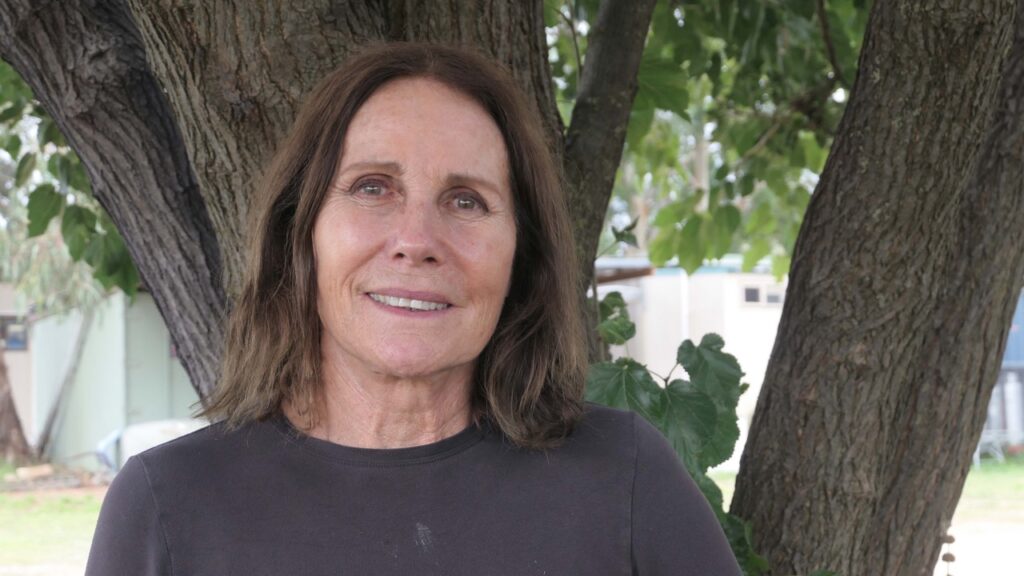
By Jenni Savigny
Brumation. Penny is talking about volunteering with the Canberra Snake Tracking Project that operates at the Canberra City Farm, as well as some other locations in Canberra. I’ve seen their signs around the farm and noted the snake bite kits but never heard this word before. I don’t find it in my Macquarie Dictionary when I get home.
Penny has been volunteering for the past three years, tracking the movements of three or four Eastern brown snakes in the area of the farm and the Jerrabomberra Wetlands. She speaks passionately.
‘I don’t know a lot about snakes but I do know how gentle, secretive and shy they are. I do know how amazingly well-camouflaged they are. I do know how special they are.’
This is what’s involved: a vet fits a transmitter to the snake and then it’s released. Penny and Deb check the location of the snakes, using tracking equipment, a triangulation method, and a GPS and then upload data. In summer they are tracking three or four times a week but in winter it’s only once or twice a week because the snakes brumate: they go underground but come out from time to time to eat, maybe on a warm and sunny winter’s day. In contrast to hibernation, the snakes are not in a state of deep prolonged sleep.
Penny wasn’t always so interested in snakes and describes how snake-tracking has helped her conquer fear. She enjoys the tranquillity of the Jerrabomberra Wetlands, the company of Deb, the other half of her volunteer team, and what she is learning about snakes. For a while they were tracking a snake called Penny, who has now had her transmitter removed and been released. Penny says she definitely felt an affinity for Penny, and has seen her a couple of times in the wild, recognizable by her distinctive markings.
However, it was rhubarb, not snakes, that originally brought Penny to Canberra City Farm.
‘My whole family is obsessed with rhubarb,’
She started with a plot, growing massive quantities of rhubarb, which she bakes and freezes for her 98 year-old father, her grandchildren, and her husband (rhubarb on porridge for breakfast, rhubarb with yoghurt for dessert). For Penny, rhubarb is a crop that looks after itself. More time for snake-tracking.
Born in Uganda, Penny moved to Canberra aged four when her father, a scientist, took up a position at the Australian National University. Penny did her teacher training in London, worked there for four years, and then came back to Canberra where she has raised four children and now retired.
I notice that my conversation with Penny has softened the edges of my fear of snakes and piqued my interest. I thoroughly recommend the Canberra Snake Tracking Project on Facebook where you might find a photo of the other Penny.
Spotlight – March 2023 Newsletter
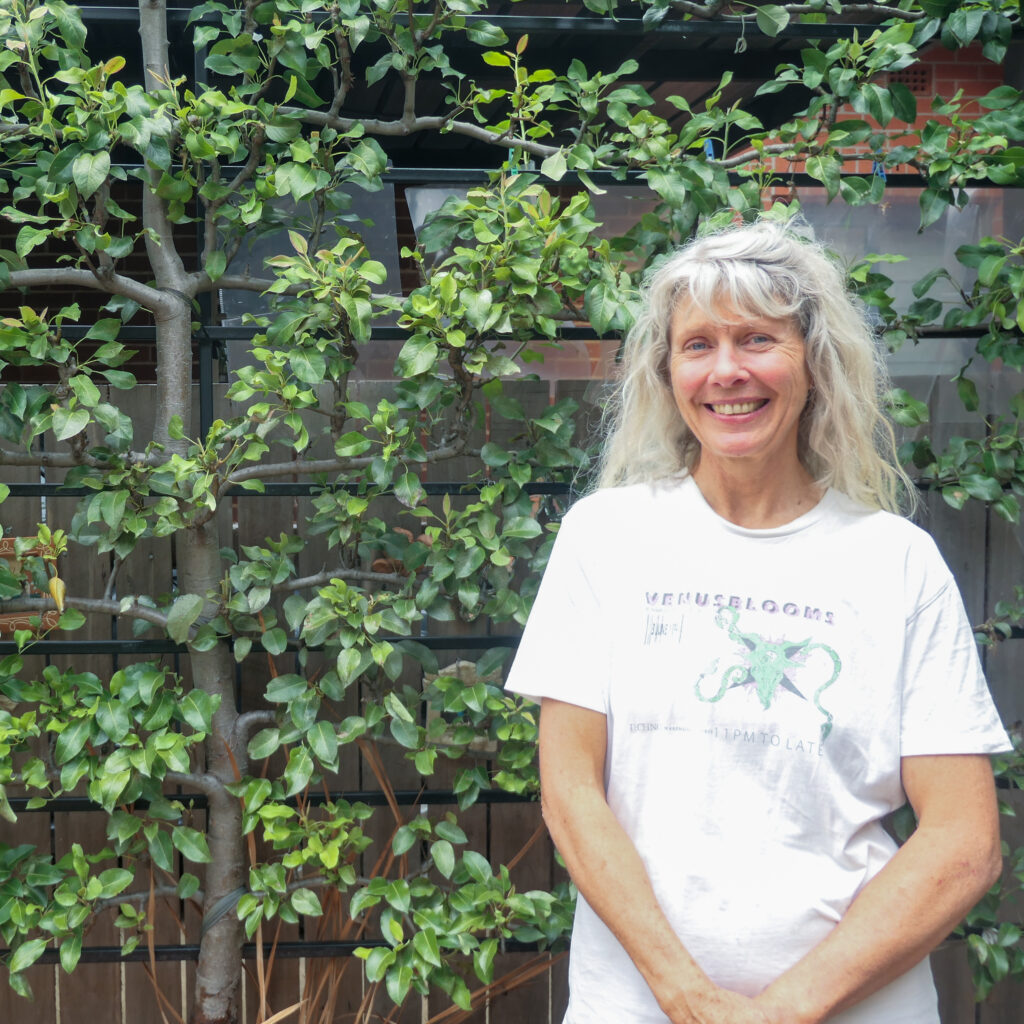
by Jenni Savigny
‘It’s all about soil’. Michele doesn’t hesitate in answering my question about what she’s learnt over a lifetime of gardening in Canberra. We’re sitting on her back veranda in Braddon looking out over what is now her sixth garden. She lists them all, starting with when she was nineteen, just out of home, renting (and gardening) in Lyons. Before that?
‘My dad was a very keen vegetable grower and I used to help him’.
We dig down into some detail about soil.
‘I try to create a really great ecology down there, giving them lots of stuff to eat.’ Michele buys sheep manure by the garbage bin, runs a worm farm, and composts. When I knocked at the front door I noticed three large bins with a handwritten notice to ‘Scrappers’ about what not to include, fruit stickers, coffee pods. This is the composting service that she offers to neighbours through Sharewaste (sharewaste.com) processing the food scraps through a cold system with four bins.
‘Compost is king!’ she laughs.
Then there’s ‘throwing a lot of stuff on the soil’, straw or whatever she’s shredded from the garden. She doesn’t disturb the soil itself, a ‘no dig’ approach.’
Michele came to the Canberra City Farm through Canberra Organic Growers where she was the convenor at Dickson, and The Farm used the greenhouse one winter to prepare seedlings for Floriade. She’s been a regular Monday volunteer for a few years, with a break while she completed a Masters in Visual Arts. What attracts her to the farm? Communing with people with a common interest in growing food, especially after the social isolation of COVID times. She has worked on many different projects, but is particularly passionate about growing fruit
‘I think the fruit tree area could use a little love,’ says Michele. She’d like to see a small team working on the old orchard.
Her most recent initiative at The Farm has been to start an Instagram account. As an independent artist she’s had to learn to promote herself through social media and promoting The Farm was an obvious extension of this skill. Have a look: https://www.instagram.com/canberracityfarm/ and see The Farm through an artist’s eye.
On the way out, I’m captivated by the beauty of an espaliered pear tree in the driveway and this is where I try my own hand at photography. The passionate fruit grower explains the plastic flaps: physical barriers to the ‘furry creatures’ that make fence lines their highways. We say our goodbyes and she heads back to her garden studio.
Now we get to promote Michele! Have a look at her art practice: http://micheleengland.com/. I was particularly taken with her collaborative project to create a quilt about the 30+ species and 2 ecological systems that are threatened in the ACT. Michele has a deadline, Threatened Species Day in September when the quilt will be presented to the Legislative Assembly.
Spotlight – October 2022 Newsletter
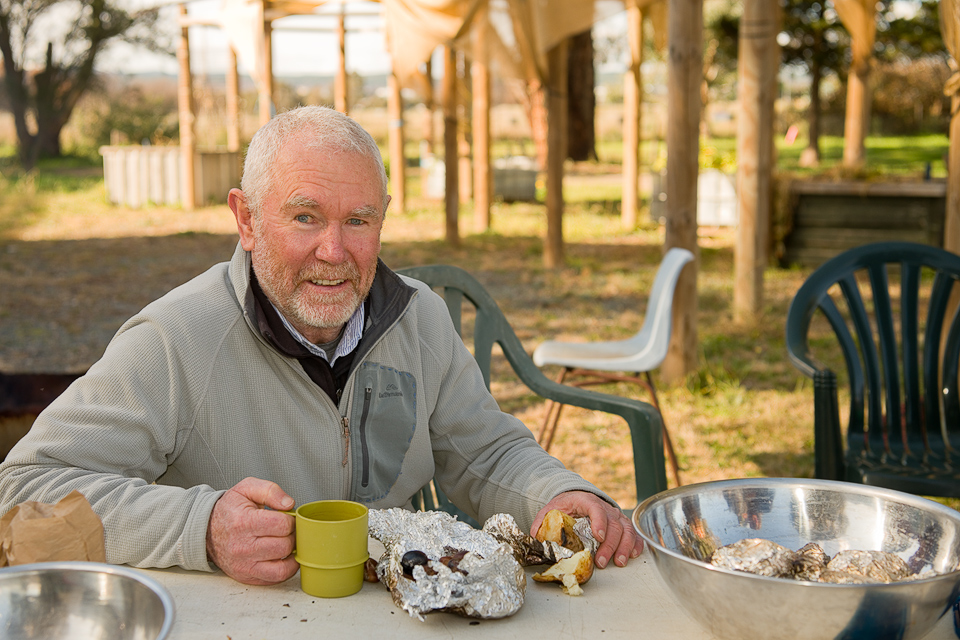
by Jenni Savigny
“I couldn’t say that I’m really a gardener”, Mark opens. He confesses to weeds, ivy, and a wicking bed of lettuce that’s gone to seed. For a non-gardener, Mark’s been involved with the Canberra City Farm for a very long time, ever since the first meetings at Downer about ten years ago.”My involvement with the Farm is more about building cultures of collaboration, community, abundance, and sharing”, says Mark.
“So you do garden, but with people, communities, and ideas”, I venture, and Mark nods. I’m allowed to play with this metaphor. Mark has some big ideas; let’s call them seeds. He wants to create a life-sustaining system that flourishes; a culture of collaboration, thriving, learning, and connecting with nature. So how to “garden” such ideas? The paradox is that Mark doesn’t spend a huge amount of time at the Farm. There are probably lots of people who may not know him, and his work is most effective when it’s not really noticed. He enjoys providing a form of leadership whereby people learn to enjoy working together, can navigate difficult conversations, and enjoy creating something bigger that just individuals growing their food in individual garden plots. He has tended these “idea-seeds’” through some tough years as the Farm has grown. Mark remembers the Farm’s finances, from a tin full of fifty-cent pieces to today’s five-digit budget that has been built by volunteer efforts such as selling seedlings and processing food.
Pizza events at the Farm: let’s call them metaphorical compost days, feeding body and soul, nourishing community. Mark likes to cook potatoes and enjoys sitting around the fire and hearing people talk, tell stories, and share. I imagine this and ask my next question.
“‘So tell me about you’, says the new person sitting next to you. What do you say?”
Mark grew up in Cabramurra and Khancoban. He is very happy to be the father of three children, though sadly his son died, aged 30. Then there are echidnas. If Mark had been born indigenous, part of the culture would be to have a totem from this landscape, and he’s fond of echidnas. He likes how they hang onto the earth really tightly when they’re threatened; know where their food is; and carry a certain wisdom.
Caring for country and caring for people: that’s Mark’s type of gardening. And it doesn’t stop at the Farm. Mark’s vision is for Canberra to be a regenerative city. Plenty of gardening work to still be done!
Spotlight – September 2022 Newsletter
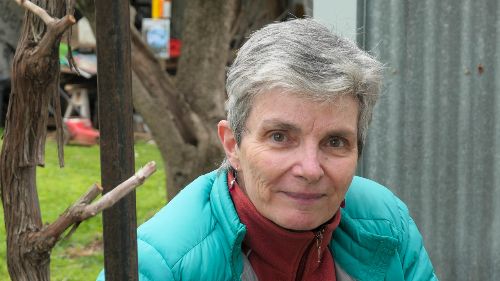
by Jenni Savigny
“I was actually born here”, Virginia tells me. And before I can say wow or even raise my eyebrows she continues, “You can touch me!” We laugh.
Virginia’s memories of Canberra take me back two generations, when the dump was “over there”. We’re sitting outside at Canberra City Farm near the pizza oven, and she points south toward Jerrabomberra Creek.
“In those days you could entertain yourself for a whole afternoon with Dad.”
She remembers Pialligo when it was a food market while Canberra was being built, and she remembers a moment in the 1970s when Canberra was caught with only two days of food on the supermarket shelves. Trucks had blockaded the four roads in and out of the city as a political protest. It was an early lesson in the need for everyone to grow a little bit more food.
Then our conversation moves to France and back a generation. Virginia’s grandfather came from Bordeaux and arrived in Australia as a 15-year-old, not speaking English. France continued to be an important place in Virginia’s life because she married a Frenchman, and, with their children, the family moved back and forth between France and Australia. It’s clear that her interest in community gardens is international and long term. “Living in Pau, near the Pyrenees, we found a community farm just like this with containers and volunteers and workshops. They’re all over the world.”
Now she lives in Tuggeranong, and has a few veggie patches, a few fruit trees, and a wonderful dog called Zip (who sometimes likes to lie on small seedlings).
About ten years ago Virginia started going to meetings at Downer about setting up a community farm in Canberra. “I’ve been a volunteer from the conception.”
Virginia is a midwife, recently retired, so her choice of word sends me deep into metaphor as she talks about what she loves: people, being outside, gardening, harvesting, learning, tomatoes, and a long list of morning-tea delights. We’re looking out over the vineyard and the Jerrabomberra Wetlands. “It’s a beautiful place for animals’, she says.
She briefly mentions a black snake called Penny, and the abundant birdlife has already delighted my ears. I’m remembering my joy at the fairy wrens who danced on the side mirrors of my car as soon as I pulled up. Virginia points to a bird of prey patrolling overhead. A kestrel?
Virginia shows me around. She’s currently responsible for the farm’s seventeen wicking beds, and she’s been getting them ready for summer plantings by clearing them out, re-composting, and manuring. In the wicking bed just outside the window of the Super Shed, she shows me a grape they’ve just transplanted from the vineyard in the hope that it will provide shade on the eastern side.
We peep inside the propagation shed; we walk past two women packing fresh food boxes for Southern Harvest. Virginia is showing me one of her favourite things about the farm: collaboration.
Spotlight – August 2022 Newsletter
by Jenni Savigny
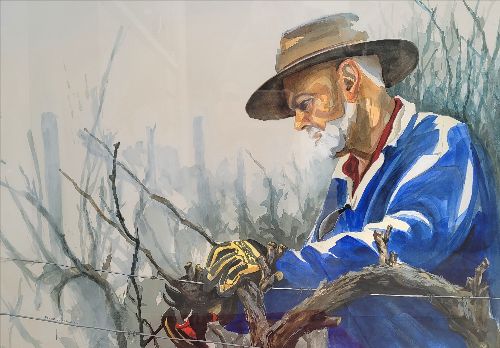
When Adelaide has a run of days of forty degrees, then it’s time for grape-growers of Canberra to water; a heatwave is surely on its way. That’s one rule of thumb that Phil Thomson shares with me as he prunes the vineyard at the Canberra City Farm. Today it’s about six degrees, and a grubby, Canberra-in-July fog is still hanging low into the mid-morning. Phil is rugged up. A pair of thick yellow gloves protects his hands from the cold and also from the secateurs that punctuate our conversation.
Part of being a viticulturist means learning to watch the weather closely.
“You need to be reasonably proactive”, says Phil. “When something gets out of hand. it’s usually too late. But with grapes it’s only too late for that year. Next season, you get another chance.”
When Phil first took over care of the vineyard at the farm, it was just after Black Summer, and the hot and dry conditions meant that the grapes had put on very little growth. A friend, a plot-holder at the Farm, had roped Phil in.
“The grapevines were a mess”, he says.
He likes a challenge; being outside; the changing seasons.
For 30 years, Phil worked in an office doing computer technology, but in the mid-1990s he made a career change. He planted grape vines on his small rural property between Hall and Murrumbateman, and he studied viticulture at Charles Sturt University by correspondence. His career in viticulture lasted until 2016, when they sold the property and moved into Canberra with a suburban-sized garden (and a dog called Coco that Phil describes as a crazy Schnoodle).
The vineyard at the Farm is much smaller than the one Phil used to own. This means that jobs such as netting and spraying are done by hand rather than by tractor. He tells me that there is a good range of organically registered chemicals available with which to manage the vineyard. With the amount of rain we’ve had over the last two years, spraying to manage disease has been a priority.
The rain has also meant that the grapes have grown madly; and, without the usual heat of summer, they haven’t stopped. Today Phil has cut the main cordon of a grape that is the thickness of my wrist. His pruning aim is to reduce all the vines to one height and reduce the number of shoots so that there is growth on fewer canes. As the foliage grows, he will keep lifting the wires to train the shoots upwards.
In the past couple of years, the grapevines at the Farm have only produced enough fruit to make jellies and vinegar. There’s wine-making equipment at the Farm that Phil clearly wants to use at harvest time next Autumn. There’s not much to do in winter, but come October you’ll find Phil in the vineyard on a Monday, managing the growth, the fruiting, the ripening. Another season, another chance.
Spotlight – June 2022 Newsletter
This month we feature one of our Working Wonders volunteers, Lis Napier. Lis has helped with many and varied tasks around the Farm, including sprucing up the paint work on the shipping container below.
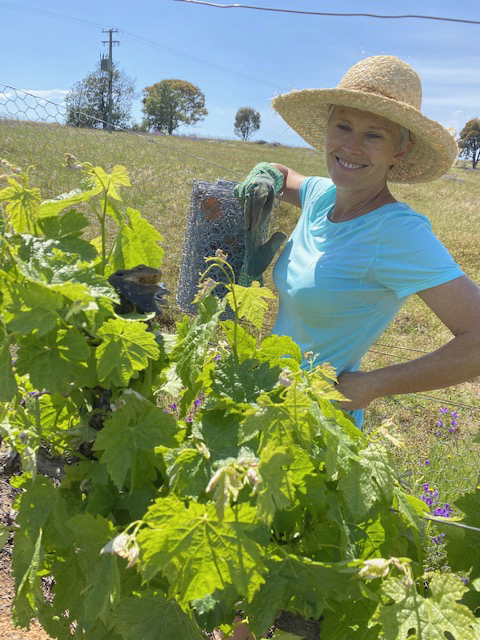
What drew you to Canberra City Farm initially?
I had just moved back to Canberra after being away for seven years: two in Dubai and five in my home town of Melbourne. When I’d last lived in Canberra, I was working full time for a software company and helping to raise my three stepsons, so had very little spare time for volunteering on a regular basis. So this time around, being retired, I was looking for something where I could meet like-minded people, enjoy the outdoors and get some physical exercise, plus give back to the Community. While in Melbourne I’d been involved two days a week with the local Primary School’s Stephanie Alexander Kitchen Garden programme, which I’d thoroughly enjoyed, so I was keen to find something “garden related” and local to my suburb of Kingston if possible. After some googling, the Canberra City Farm popped up — it seemed to tick all the boxes! I turned up one cool Monday morning for the infamous John Peters tour of the Garden and was so impressed by all the activities that were going on, plus absolutely loved the history and setting of the place. So now I can ride my bike through the beautiful wetlands and enjoy time with many fabulous people and hopefully contribute something small.
What’s something you enjoy about spending time at Canberra City Farm?
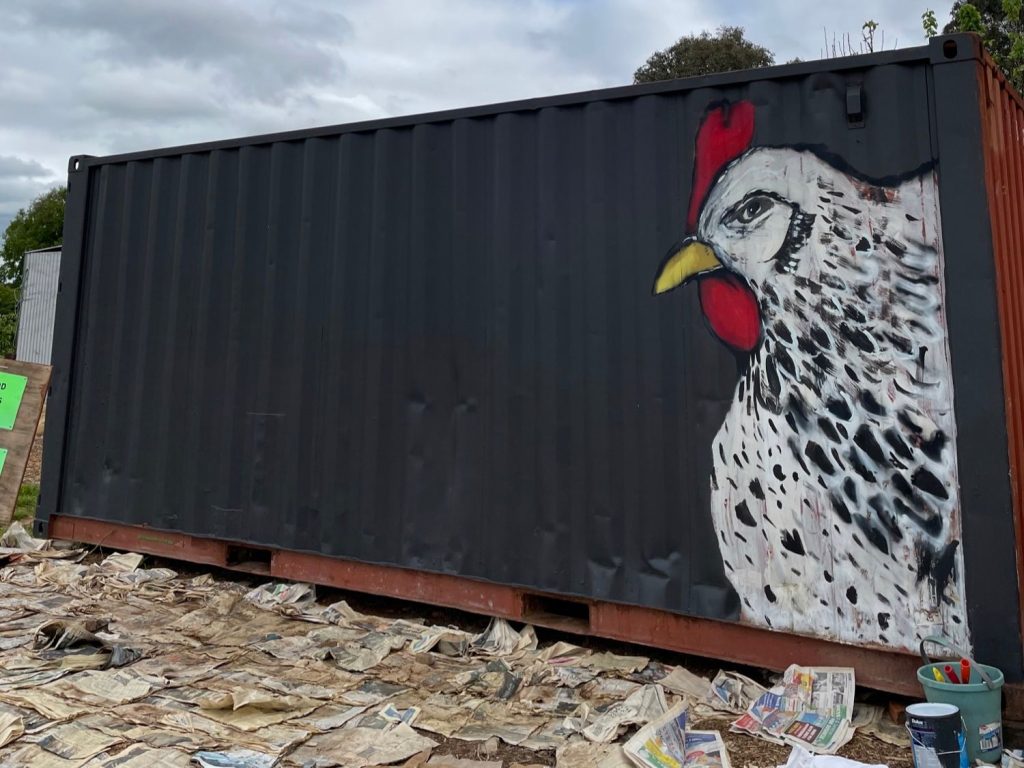
I absolutely love the wonderful people I have met at the Farm. Everyone has an interesting background, are genuine and down to earth and share a common commitment to giving something back to those who are less fortunate as well as sharing their own knowledge and experience amongst the Farm community. A few hours at the Farm enables you to forget about everything else and enjoy being in the outdoors doing something worthwhile. We also have a good laugh about things, which is something that also makes it a great day out! Every week there is something new that needs to be done, so there’s also the opportunity to learn from others.
What’s your favourite thing to do on a wintry day?
The best thing on a cold, grey Canberra wintry day is to get out, shovel some mulch, weed some beds, or do something nice and physical to keep warm and enjoy the fresh air. Much better than being inside on the couch!
What’s your favourite thing to cook/eat from the garden?
I’ve loved everything I’ve brought home from the CCF! From the ruby red figs, to the bright green silver beet, rustic green, and purple beans — it all seems to taste much better when you know where it has come from and maybe have had some part in its production.
Spotlight – April 2022 Newsletter
In April we aimed the spotlight at our dedicated volunteer and champion of the four-bed demo garden, Margaret Bonner.
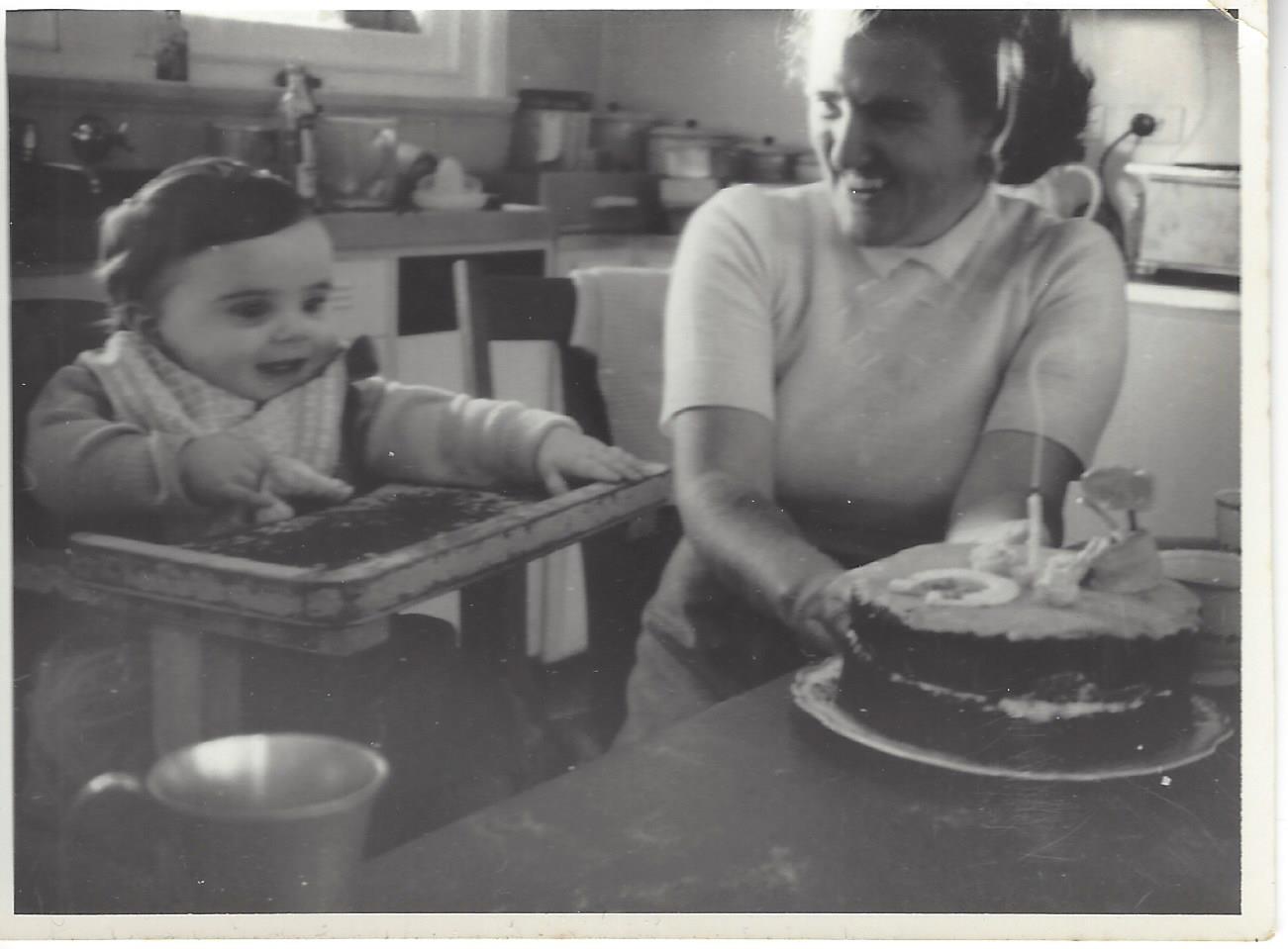
What drew you to Canberra City Farm initially?I was wandering around Floraide and thought all of these lovely flowers, but where are the vegies… which also flower! Then I came across the CCF stand, and after talking with the people there thought now this is an organisation that I like the ethos of. The rest is history.
What’s your favourite thing to do on a sunny day? What do I do on a sunny day when gardening? Well, it all depends on the season. If it is hot: watering, mulching, and shading plants from the sun. If in winter, then I’m rugged up and sitting outside enjoying the warmth with a cuppa. And in between could really be anything from collecting mulch to starting seedlings. When not gardening, then swimming in the Jervis Bay area.
What’s your favourite thing to cook from the garden? It would have to be pesto from my basil with a tomato, leafy green, garlic, and red onion salad.
What would you like to see in Canberra’s future? While I could talk about this all day, it can be distilled down to this: basically leaders and a community that are inclusive and respectful of all, with opportunities to explore new horizons whatever they might be.
Spotlight – March 2022 Newsletter
In March we focussed the spotlight on one of our founding members Keith Colls.
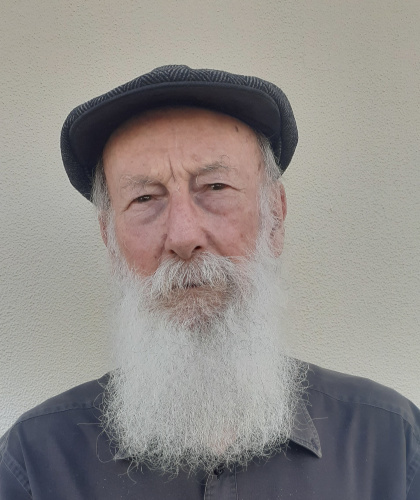
What sparked the idea to create Canberra City Farm? At the time (2010) a few of us were thinking about how we could locally address some of the environmental issues of the time (such as climate change, soil degradation) and the potential consequences that followed, such as insecure water supplies, diminishing food security etc. The underlying problem was that our extractive societies (including our own) were living beyond the capacity of the earth’s ecosystems to respond to humanity’s demands and, as a consequence, those ecosystems upon which we depend (and are an integral part of) were being seriously, and probably, irreparably damaged.
We felt that the best we could do was to create an organisation to promote, facilitate and demonstrate a sustainable way of living where the capacity of the local ecosystem functions which support our local community were not exceeded, that is, we could live in harmony with our local environment into the foreseeable future. This is the fundamental idea which underpins the work of the Canberra City Farm. In essence, it is an educational organisation where we explore and facilitate, through practical hands on experience, how the issues of practical living within the constraints of our local environment can be addressed. The educational and facilitative work of the City Farm has three main components:
- Exploring the relationship between the local environment and its capacity to produce food, the state of our current food supply and food quality. This is largely addressed through gardening workshops/courses run at the city farm and hands on experience members gain working in the communal gardens at the farm. Other contributions include a large range of talks provided at Floriade and to garden clubs. We have also provided advice to building developers establishing communal gardens in developments. We work closely with other organisations such as Southern Harvest and Regional Development Australia as well as gardening and environmentally related organisations such as the Canberra Organic Growers Society, See-Change, Environment Centre and the Conservation Council.
- Exploring the energy efficiency of our built environment. Our first building demonstrating energy efficient building design was located at Floriade for a couple of years and then moved to the city farm site at Turner. Our current energy efficient demonstration building is the LESS built by volunteers from See-Change at the current Fyshwick site.
- Exploring ways to enhance the local food economy through encouraging and supporting “start ups” (and established businesses) which support sustainable living within the constraints of our local environment and contribute to the local environment. Several “start up” businesses related to food and sustainable living are currently supported at the Fyshwick site.
What’s your favourite thing to do on a sunny day? Provided it’s not too hot, I like to sit under the shade of a big tree and do absolutely nothing except watching the birds and insects going about their daily activities in the landscape, listening to the breezes in the leaves, and perhaps having a little nap.
What’s your favourite thing to grow? There is something very satisfying about growing plants from seeds and watching them emerge out of the soil. In the veggie plot, nothing looks better than a nice straight row of carrots.
What would you like to see in Canberra’s future? I would like to see a healthy local food economy based in the Capital region where we produce a significant amount of our own food and fibre, much of it being grown in local market gardens, and supported by a growing locavore tradition developing amongst consumers. I would like to see a well resourced training facility (perhaps based at CIT) for budding farmers to build their regenerative farming skills. I would like to see building codes which ensure we have the most energy efficient buildings as possible to suit our climate. I would like to see zoning rules which protect agricultural land from being used for other purposes and which provide farmers with long term tenure to ensure their investment in soil building is not lost when the land is sold.
